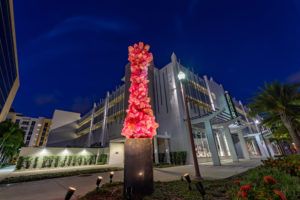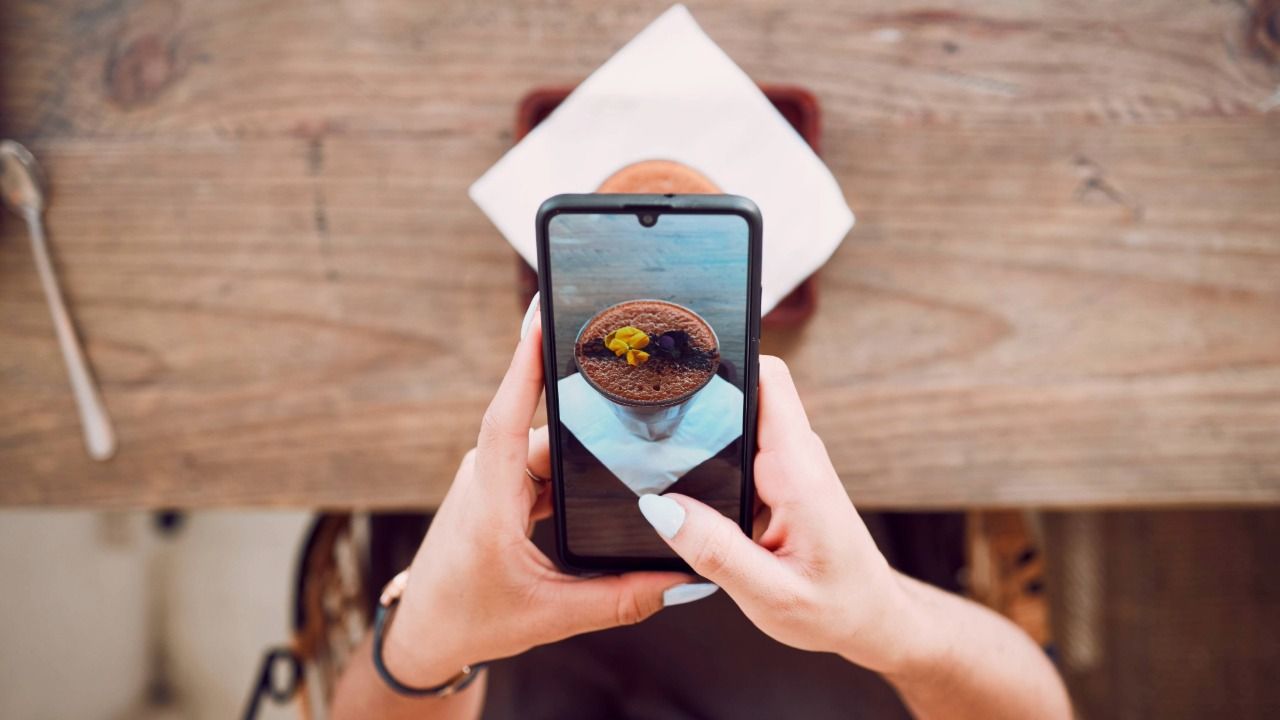St. Petersburg’s best-kept glass art treasure secrets are hiding in plain sight. In the middle of downtown, opposite William’s Park, at 212 Third St. N. is an old brick church, with a statuesque bell tower, which is a National Historic Registry Site: First United Methodist Church.
As one of the premiere arts destinations in the South, St. Petersburg boasts fabulous collections like the Salvador Dali Museum, the James Museum of Western & Wildlife Art and the Museum of Fine Arts. Perform a Google search on “glass art St. Petersburg” and the Chihuly, Morean and Imagine Museums likely will show up, but not the First United Methodist Church.
Built in 1926, the modified Gothic architecture of the building itself is enough of a lure to entice art aficionados. Inside is the sanctuary, where the inverted ark ceiling looms above a magnificent ship as a symbol of the story of Noah’s Old Testament flood. To the left of the altar is a remnant of the original bell tower. To the right of the altar is the “sacred desk,” a lectern used in the church by guest speakers such as Norman Vincent Peale and Helen Keller, among other early-20th century luminaries.
Stand at the front of the church at the altar and turn around, facing the narthex or back of the church. This is the best vantage point to reveal all 10 Tiffany-style stained glass windows: five along the west wall, four along the east wall, and one that, by itself, appears to consume the entire south wall. The largest stained glass window is the centerpiece, depicting a recreation of “The Last Supper” of Christ with the 12 disciples sharing the last Passover supper the night before the crucifixion. The original painting by Leonardo da Vinci resides in a modest monastery in Milan, Italy and was nearly destroyed during World War II, but has since been restored.
A balcony in First United Methodist Church separates “The Last Supper” from another stained glass window above the balcony that is a cathedral-design window, giving the optical illusion that the two windows are actually one, though they are not. “The Last Supper” stained glass window is 10 feet by 18 feet, but it seems larger than life, even though it is only 40 percent the size of the original Da Vinci painting.
On the outside of First United Methodist Church, “The Last Supper” stained glass window faces Second Avenue North and is the only stained-glass window illuminated from the inside of the church every night, making it the solitary glass art treasure visible to all, from the street, in the dark. A good location from which to view “The Last Supper” at night is diagonally across the street in front of American Stage. The elevated colors, textures and personalities of the subjects in the stained glass window are clearly elucidated.
The collection of the stained glass windows is called “The Life of Jesus Christ,” and each window portrays chronological segments of the life of Christ, from birth through ascension into heaven. These nine windows are 40 inches by 63 inches each. Every window is a reproduction of renowned religious paintings from the 1700s to 1900, including works by Johann Heinrich Hoffmann, Bernhard Plockhorst and Gottleib Peter Biermann, among others.
“Some of the original paintings were destroyed during the bombing of Germany, during World War II, so in one or two cases we have the only remnant of the original artwork,” says Sue Allen, chair of the docent committee.
The signature of Tiffany-style stained glass windows made between 1880 and 1930 is opalescence, a manner of layering and coloring the glass to give it depth and brilliance. Opalescence is particularly visible in the glow of fabrics depicted in the glass.
“Molten glass was moved with a 3D-like rolling pin to push thicker and thinner areas that let light through in different ways,” Allen says. “Opalescence is not done today, due to the toxic chemicals that were used.”
Another technique used was called “frit” to paint the fine details like hair, facial features and nuanced expressions. This was achieved by grinding colored glass and mixing it with oil (frequently olive oil), painting it on and then firing it to make a permanent bond.
Back in 1924-26, when the church was built, it cost $450,000 to construct the building and $9,000 for the stained glass windows, a fraction of their worth today. The population of St. Petersburg in those days was 25,000 and the church seated 2,400 parishioners. Allen explains that in the early-20th century, people were not literate as they are today. Stained-glass windows, both in the United States and Europe, were pictorial alternatives to reading the Old and New Testament stories. “It (stained-glass window art) was the poor man’s Bible,” Allen says.
These stained-glass windows were designed for, and installed in, the church by George Hardy Payne Studios of Paterson, New Jersey. Allen explains that the Studios merged in 1981 with Rohlf’s Stained and Leaded Glass Studio of Mount Vernon, New York.
Kokomo Opalescent Glass Co. of Indiana, the oldest stained-glass producer in America, founded 1888, made the stained-glass segments. “Kokomo is still the main source for restoration of stained-glass and Tiffany windows,” Allen says.
With a resurgence of interest in stained glass, and the unique American style of Tiffany windows, many visitors are fascinated with the splendid glass art they see at First United Methodist Church. Docents receive a full year of in-depth training on the history, art and spiritual elements of the stained-glass windows before they give tours. Every Wednesday at 11 a.m. one-hour docent-led tours are conducted free to the public. Although the tours are free, donations are accepted. For more information call First United Methodist Church at 727.894.4661 or email Allen at [email protected].
Renowned Glass Art Treasure Venues in St. Petersburg
Whether glass art is exhibited in natural, or artificial light, light illuminates glass art to reveal an inexplicable magic when the photons reach the glass and a prism of possibility unfolds a deeper engagement for the beholder. St. Petersburg is known as the sunshine city, so it is no surprise that some of the most glorious glass art in the world resides there in major venues such as the Morean Arts Center Glass Studio and Hot Shop, the Chihuly Collection, Duncan McClellan Gallery and Imagine Museum.

The Morean Arts Center was the first art gallery, south of Atlanta, to open in St. Petersburg 103 years ago. This venue grew from its modest beginnings as an art club, to a must-see that includes the arts center, glass studio and hot shop as well as a center for clay. The arts center’s slogan is “Local artists creating world-class art.” Behind the Morean Arts Center (719 Central Ave.) is the Glass Studio and Hot Shop at 714 Central Ave. where there are narrated glassblowing demonstrations Wed. – Sun., on the hour, from noon to 4 p.m. Special events like one-on-one glassblowing, ladies night and hot dates in the hot shop, make a glass mug and sculpt a glass flower, are offered regularly on scheduled evenings.
In 2010 the Chihuly Collection opened. Presented by the Morean Arts Center, it is a permanent collection of world-renowned American artist Dale Chihuly’s glass art and was the first installation of Chihuly’s work. It is easy to spot since the entrance at 720 Central Avenue is, dare one say, a stone’s throw away from the Morean Art Center, and has an iconic 20-foot Chihuly sculpture designed for the site in front of the building. Inside are the magnificent color, form and large-scale blown glass Chihuly is famous for in his creations of chandeliers and cylinders, glass orbs and shapes that resemble real-world life such as flowers, snakes and sea shells.
Duncan McClellan Gallery opened not long after the Chihuly Collection came to town. McClellan wanted to develop a “deeper relationship between artist and patron” and now has the largest glass art gallery in the eastern U.S. in what used to be an old tomato packing plant at 2342 Emerson Ave. South. At first, McClellan began the gallery with his own work only but developed an international reputation, and now represents 105 artists that he calls “luminaries in glass” with his successful, artist-owned and operated model. The DMG School Project, mobile hot shop, summer programs, free demonstrations and art garden, with dozens of orchids and fruit trees, are all part of the operation.
The most recent jewel to be added to St. Pete’s glass art crown is the Imagine Museum of contemporary studio glass located at 1901 Central Ave. Opened in 2017, the museum features 500 pieces, from their 1500-piece collection, in 36,000 square feet of gallery space. Exhibitions change periodically throughout the year to give new artists visibility. Interactive spatial computing opportunities of augmented reality, and virtual reality, are offered to keep the medium relevant to the technologically savvy. The museum hosts multiple events, tours and educational programs as well.













